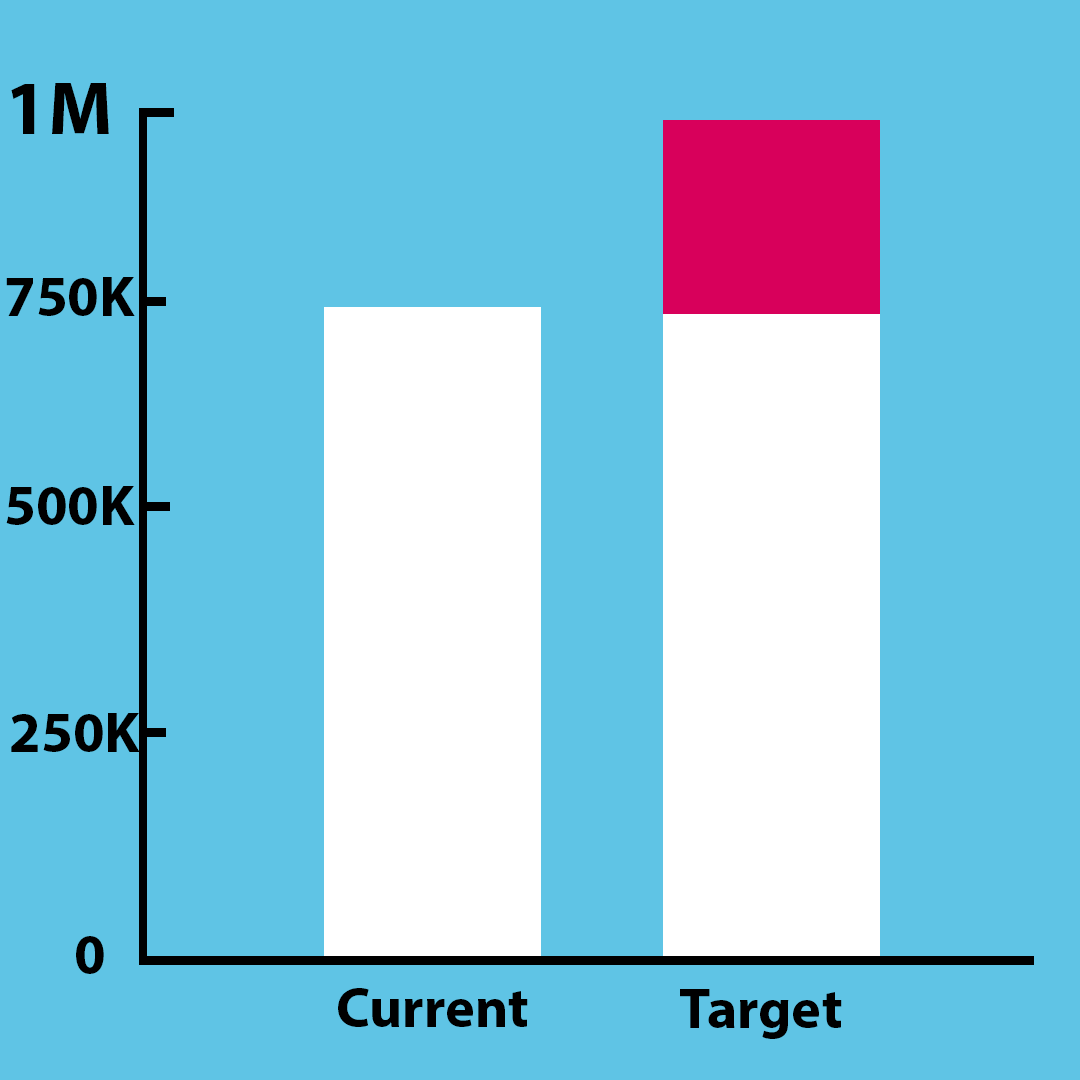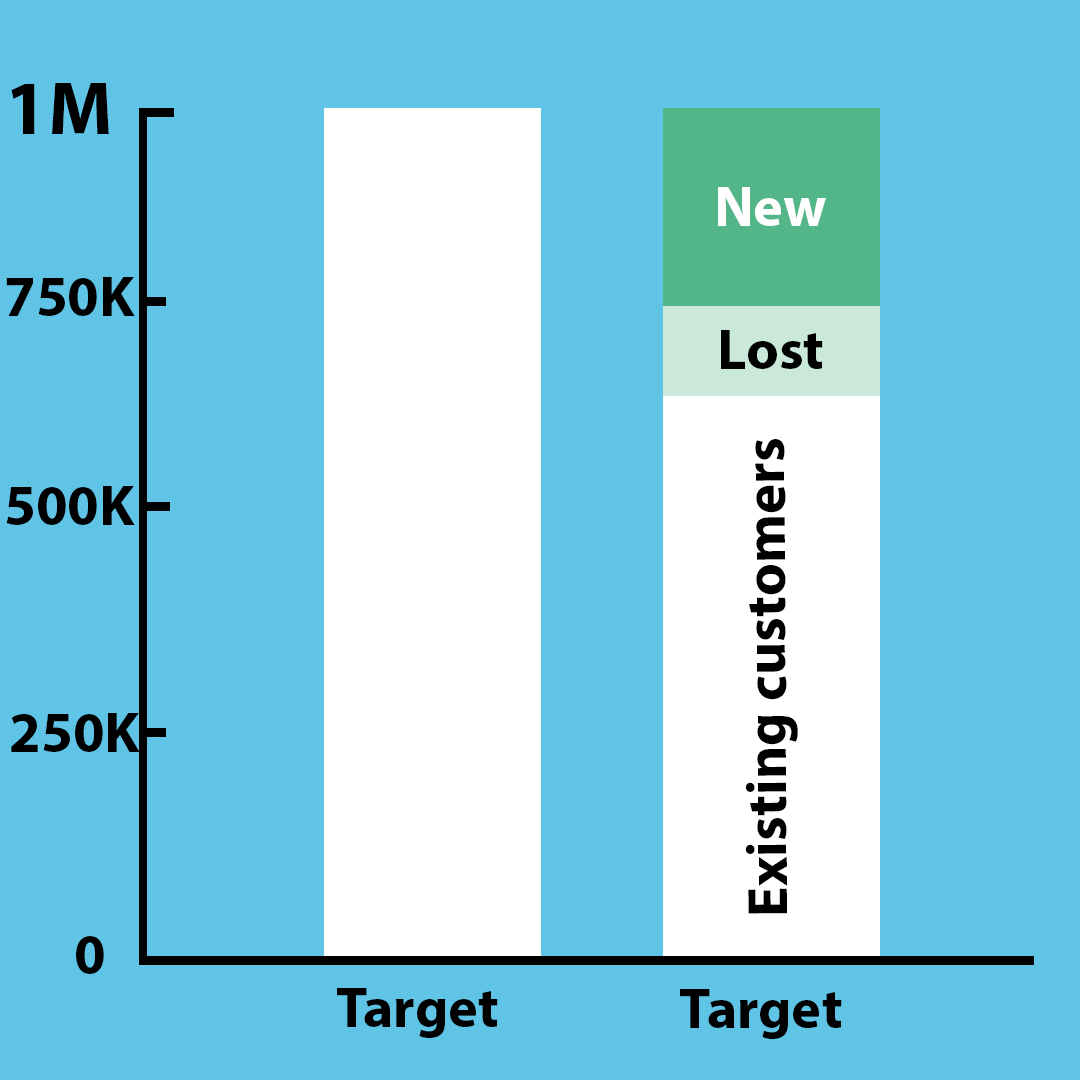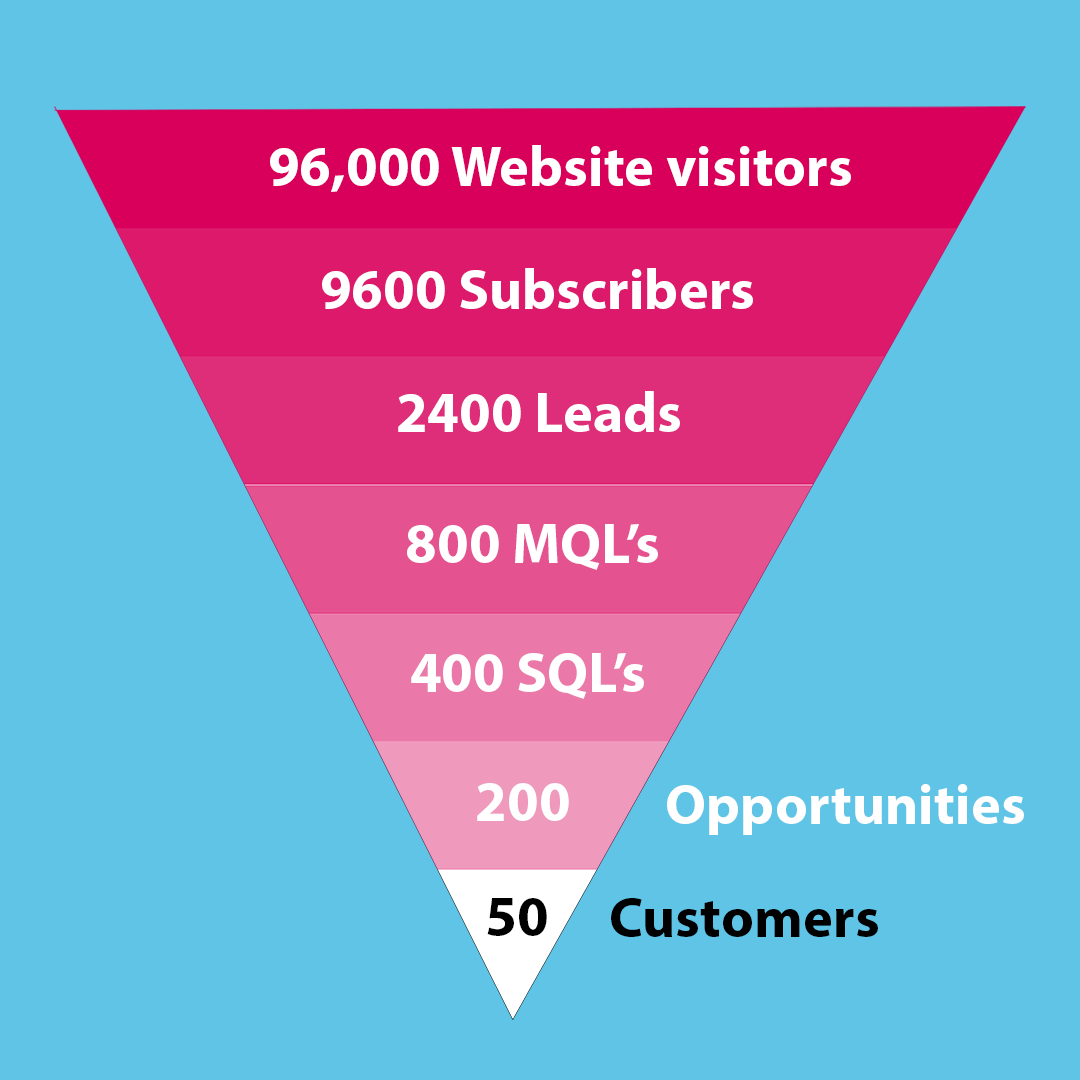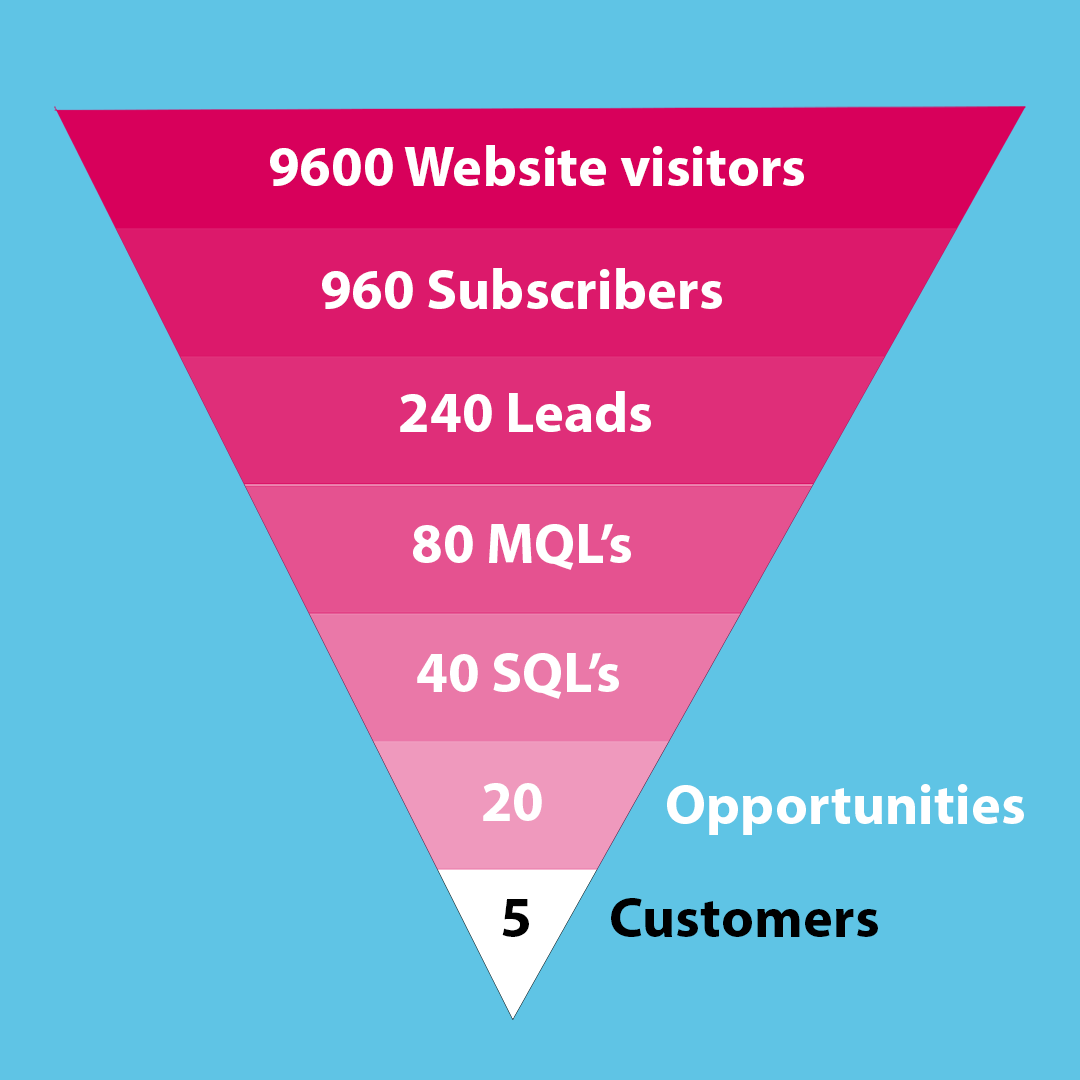From a recent survey I ran, the overwhelming result was that pipelines and targets had plenty of room for improvement. If you’re in that category I’ve written this blog post for you. I’m going to give you an outline of how to plan your sales pipeline and set useful targets.
If you’re tight for time, bookmark this page and come back to it when you’ve got a spare 10 minutes to truly digest the information in this post.
Let’s get stuck in. Here’s what we’ll be covering in this post:
- Why sales pipeline targets are important
- Your customers' journey
- Common steps in the sales pipeline
- A recommended sales pipeline
- Setting your 12 month target
- Creating staged targets
- Next steps that you can take
Why are sales pipeline targets important?
With the uncertainty of recent times, I've seen lots of people questioning the value of targets. Many of them are the type of people who would have been advocating their benefits not long before the uncertainty hit.
It's a bit like when you're going on a journey, you have a clear destination and ideal time of arrival. When you do, it makes it much easier to work out your method of travel and the route you're going to take.
Let's say you're driving by car, you'll work out the ideal route on Google maps and you'll plug it into your sat nav. If there turns out to be unexpected delays on your chosen route, you'll pull over and check out some alternatives that will get you to where you need to be on time. (Or your sat nav will work it out automatically for you)
Now compare that to if you weren't clear on your destination and the time that you wanted to arrive. You might end up at the same place at the same time, but it would be much less likely.
Good targets give you focus and a time frame. They help you set your route and adjust it if things unexpectedly get in your way.
When you approach them in that way, they are a positive force to help you achieve your business goals. Few things in life are certain, but if you don't have targets you certainly won't achieve them.
Your customers' journey
Everyone of your customers goes on a journey when they are buying the product or service that you provide.
The typical customer journey, described as the general stages a customer goes through on their buying journey, looks a little like this:
-
Awareness (Aware that they have a problem that needs fixing)
-
Consideration (Researching and considering options to fix their problem)
-
Decision (Making a decision on which option to choose)
-
Delight (Ideally being delighted with the purchase they have made)
You can describe the customer journey in other ways too. When you’re looking at the customer journey, you really want to put yourself in their shoes and look at the questions they’ll be asking at each stage of their journey.
By doing this you’ll develop a much deeper understanding of your customers’ experience, which will make it much easier to see where you can make improvements for them.
Common steps in the sales pipeline
Another way of looking at the customer, is the journey they take with you from the perspective of your business. Here’s some common steps for a B2B business:
- New website visitor
- Subscriber (they subscribe to content that you create, ideally with an email address)
- Lead (they take an action that means they meet the criteria that you would consider them to be a lead or prospect)
- Marketing Qualified Lead - they meet the criteria that mean they are ready to have a sales conversation with your sales team
- Sales Qualified Lead - they meet the criteria that your sales team consider them to be a good fit and sales ready
- Opportunity - you have an active opportunity of doing business with them
- Customer - they are an active customer of your business
- Evangelist - you’ve delighted them, so they are happy to recommend and advocate your business to others
This description is what we call the pipeline. It’s your customer's journey with you from the perspective of your business. It won’t mean anything to your customers, but for you, it’s crucial.
A recommended sales pipeline
Your sales pipeline will typically start when you know who the prospect is, which will be when you have some contact details for them. A name, an email or a telephone number.
It’s good that you have visibility of how your pipeline is performing from as early a stage as possible.
If you know how many website visitors you need to generate the leads that will help you achieve your sales targets, you’ll be able to see from an early stage, if you’re on track for achieving them. If you can see that you’re not, then you’ll be able to plan other activities that will increase the chances of you achieving your goals.
This means that while it may not be strictly part of your sales pipeline, including a leading indicator like website visitors, or new subscribers can be useful to build into your reporting.
At a minimum your sales pipeline should include the following steps:
- Sales Qualified Leads (SQLs)
- Opportunities
- Customers
- Evangelists
- I’d argue that it should also include:
- Leads and
- Marketing Qualified Leads (MQLs)
Leads and Marketing Qualified Leads will both be the responsibility of your marketing team, but it’s a good idea to include them in your sales pipeline reporting as it’ll give you a full picture of how everything is flowing and whether you have blockages at any point in the pipeline.
As well as recording actual numbers, also work out the conversion rate as a percentage between each stage of your pipeline.
Setting your 12 month target
Where do you want your new business to be in 12 months? What is your goal?
Let’s say that your revenue is currently at £750k and you want to break the £1m mark. That means you need to generate £250k of new business in 12 months.

You’ll also need to build your pipeline, so that you have everything in place to continue your growth trend beyond that. Here’s a few things that you’ll want to work out to help you with your targets, I’m also going to include some answers to the questions that I’ll use in my example sums below.
- What is your average new customer worth to you per year? (£10k)
- How many customers do you lose on average per year? (20%)
- How many opportunities do you need to generate a new customer? (4)
- How many SQLs do you need to generate an opportunity? (2)
- How many MQLs do you need to generate an SQL? (2)
- How many leads do you need to generate an MQL? (4)
Imagine that you have these example figures, feel free to swap them out for your own numbers if you want to.
Using this example you need to generate £250k of new business in this year, plus also account for a 20% loss of customers, which is another £150k.

So in total you need your pipeline to generate £400k of new business.
You also want to continue the growth trend into the following year. So you’d probably want to increase your 12 month pipeline target by another 25%, so that you’re going into the following 12 month period with a strong pipeline.
Adding that together gives you a 12 month pipeline target of £500k, which is 50 new customers, of which you’ll want about 40 to have converted in the current 12 months.
Now we’re in a good position to create our staged pipeline targets.
Creating staged targets
There are 2 parts to creating staged targets:
- Part 1: Targets for each stage of the pipeline
- Part 2: Targets for different stages of the journey to getting there. This could be weekly, monthly, 2 months or quarterly - whichever works best for your business. At LexisClick we find that 2 months works really well.
Let’s start with the targets for each stage of the pipeline.
To get these you’ll also want to answer another couple of questions:
- How many subscribers do you need to generate a lead? 4 (25% conversion rate)
- How many website visitors do you need to generate a subscriber: 100 (1% conversion rate)
To give an overview, your pipeline to reach a goal of 50 new customers would look a bit like this:

-
Target customers: 50
-
Opportunities needed: 200 (25% conversion rate)
-
SQLs needed: 400 (50% conversion rate)
-
MQLs needed: 800 (50% conversion rate)
-
Leads needed: 2400 (25% conversion rate)
-
Subscribers needed: 9600 (25% conversion rate)
-
Website visitors needed: 96000 (1% conversion rate)
Now depending on where you stand these numbers might look a bit overwhelming, but don’t be alarmed the next step is to break them down.
Looking at this total pipeline 5 new customers a month would represent a good growth rate. Building a reliable pipeline to generate 5 new customers a month from month 13 onwards would generate 60 new customers or 600k in new revenue. The chances are that if you had built that pipeline in 12 months, you wouldn’t stop there in the second 12 months either.
Let’s do this and break down the full pipeline into a monthly pipeline:

-
Target customers: 5
-
Opportunities needed: 20 (25% conversion rate)
-
SQLs needed: 40 (50% conversion rate)
-
MQLs needed: 80 (50% conversion rate)
-
Leads needed: 240 (25% conversion rate)
-
Subscribers needed: 960 (25% conversion rate)
-
Website visitors needed: 9600 (1% conversion rate)
Now hopefully those targets look a lot less overwhelming. When you look at this you might also decide that some of the targets look on the high side. You may also say that actually a smaller number of your new customers will be directly attributable to the website. If that’s the case you can adjust your pipeline targets accordingly. I’ll leave that to you, as it’s beyond the scope of this post.
Now if your pipeline is currently underperforming, it’s very unlikely that you’ll fix everything overnight. So, it’s time for part 2 of the staged targets which is to build up to where you want to be over the 12 months.
I’m going to break it down using the 2 month cycles that we use at LexisClick
- Month 2 - 1 customer
- Month 4 - 2 customers
- Month 6 - 3 customers
- Month 8 - 4 customers
- Month 12 - 5 customers
That was pretty easy wasn’t it :-)
I’ll give you the full pipeline that we’ll be targeting for month 2, that you can use as the pattern for the rest of the stages.
Target customers: 1
Opportunities needed: 4 (25% conversion rate)
SQLs needed: 8 (50% conversion rate)
MQLs needed: 16 (50% conversion rate)
Leads needed: 64 (25% conversion rate)
Subscribers needed: 256 (25% conversion rate)
Website visitors needed: 2560 (1% conversion rate)
Now you have your staged targets and most important your first stage target, you’ll want to identify the blockages in your pipeline that are holding you back from achieving these targets.
And we’ve built a free Pipeline Score tool that will help you. All you need to do is answer a few questions and in under 10 minutes, you’ll have your score and recommendations on the main areas you need to improve.
So there you go - that’s how to set your pipeline targets and how to identify what’s holding you back from achieving them.
Next steps that you can take
- Step 1: Score your pipeline using our free Pipeline Score app and identify where you can make improvements
- Step 2: Prioritise the improvements you can make
- Step 3: Plan out your pipeline, so that you can start measuring how it’s performing
- Step 4: Start making regular improvements to your pipelines, so that you consistently achieve your new business targets
Score your pipeline - and identify your priority improvements
